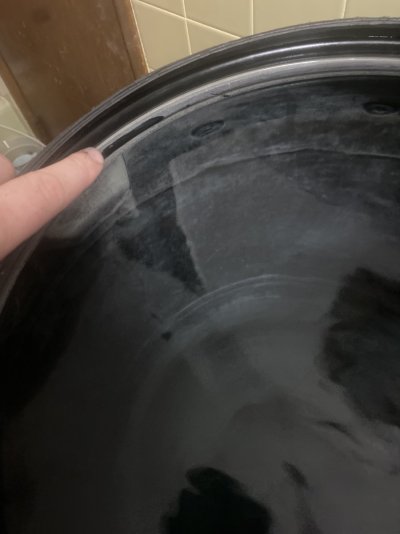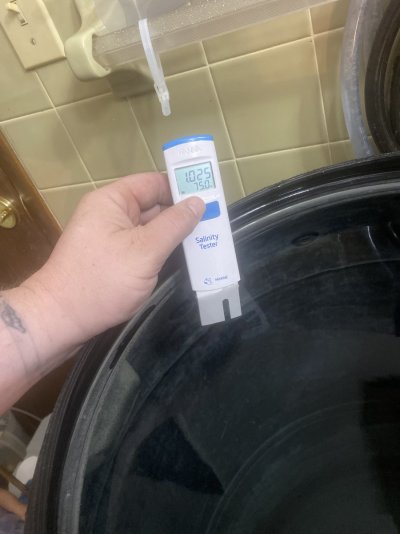Navigation
Install the app
How to install the app on iOS
Follow along with the video below to see how to install our site as a web app on your home screen.
Note: This feature may not be available in some browsers.
More options
You are using an out of date browser. It may not display this or other websites correctly.
You should upgrade or use an alternative browser.
You should upgrade or use an alternative browser.
White flim in my saltwater mixing drum
- Thread starter 60gallonrimlessYA
- Start date
- Tagged users None
It is likely fine and I have seen this happen. If you touch the surface, does it seem more oily or chalky? It could be something from the salt.
@vetteguy53081
@vetteguy53081
vetteguy53081
Well known Member and monster tank lover
View Badges
Partner Member 2024
Excellence Award
Reef Tank 365
RGB
Article Contributor
Tampa Bay Reef Keepers
West Palm Beach Reefer
Hospitality Award
Ocala Reef Club Member
305 Reef Club
Wisco Reefers
Midwest Reefer
Fish Medic
MAC of SW Florida
Rock Pool Reef Keepers
R2R Secret Santa 2023
My Tank Thread
My Aquarium Showcase
This is not abnormal. Using a mixing station, I myself get this and it seems to have happened when I started heating the water and appears the condensation from the warm water and precipitation from salt has caused this. Occasionally I open the top and wipe the side wall clean with a rag and remove this buildup
Has no impact on my water quality or fish/coral
If it is residue from the salt as suspected, then adding surface agitation (e.g., power head, etc.) will help keep it mixed in with the water.
Randy Holmes-Farley
Reef Chemist
View Badges
Staff member
Super Moderator
Excellence Award
Expert Contributor
Article Contributor
R2R Research
My Tank Thread
I'm going to remove the emergency tag. It is likely calcium carbonate and is fine.
What is that Precipitate in My Reef Aquarium? by Randy Holmes-Farley - Reefkeeping.com
Solid Residues Remaining After Preparing Artificial Seawater
Most salt mixes leave behind a solid residue when dissolved, although the extent to which this occurs varies from brand to brand. I use Instant Ocean and rarely clean out the 44-gallon trashcan that I mix it in, so a significant residue builds up over time (Figure 1). In preparation for this article I removed some of this solid material, and found that it could be almost completely dissolved in hydrochloric acid with lots of bubbling. This demonstrates that these solids were probably calcium carbonate (CaCO3), perhaps also containing magnesium. Pure magnesium carbonate is undersaturated in seawater (which is detailed in later sections of this article) 1 and should dissolve in marine systems, so it isn't likely to be the precipitated material, although there may be significant magnesium in the calcium carbonate.
Based on the fact that the material exists as sheets that clearly did not arrive in the mix (as opposed to a fine powder which might have), I conclude that at least a significant fraction of this residue formed in the barrel. I cannot, however, rule out the possibility that some solid calcium or magnesium carbonate may have existed in the salt mix and was cemented together by additional precipitation of calcium carbonate during dissolution or storage.
When salt mixes are dissolved, there exist local regions where the salt concentration is very high. In those local regions, the calcium and alkalinity must also be very high. In fact, as seawater is concentrated by evaporation, there is a well-established series of minerals that precipitate as the salinity increases. In this series, calcium and magnesium carbonate are the first to precipitate, appearing at a specific gravity of about 1.140, which is about a 50% solution of salt in water.1 Such conditions may well exist on the bottom of a saltwater reservoir as the salt is dissolving.
With some mixes (but not the Instant Ocean that I use), the initial pH on dissolution may be very high (pH 8.5-9 +). As shown in detail later in this article, pH can play a dominant role in determining the rate of calcium carbonate precipitation, and such a high pH would make it more likely to precipitate.
It has been suggested by some aquarists that some salt mixes may contain anti-caking agents, such as clays. I do not know if this is true, but if it is, they may form part of the residue that is left behind after dissolution.
In order to minimize the formation of insoluble carbonate salts when mixing, the following suggestions may be helpful:
1. Add the salt to a full batch of water, rather than adding water slowly to a large batch of salt. The latter allows a greater time at much higher than natural seawater salinity, which may tend to precipitate calcium and magnesium salts.
2. Stir the mixture vigorously as it is being dissolved.
3. If using a mix with a high initial pH, aerate the mixture as well as stirring it. The aeration will reduce the pH.
Figure 1. The residue on the bottom of the plastic trash can that I use to mix Instant Ocean. I rarely clean it out. The solid is most likely calcium carbonate.

What is that Precipitate in My Reef Aquarium? by Randy Holmes-Farley - Reefkeeping.com
Solid Residues Remaining After Preparing Artificial Seawater
Most salt mixes leave behind a solid residue when dissolved, although the extent to which this occurs varies from brand to brand. I use Instant Ocean and rarely clean out the 44-gallon trashcan that I mix it in, so a significant residue builds up over time (Figure 1). In preparation for this article I removed some of this solid material, and found that it could be almost completely dissolved in hydrochloric acid with lots of bubbling. This demonstrates that these solids were probably calcium carbonate (CaCO3), perhaps also containing magnesium. Pure magnesium carbonate is undersaturated in seawater (which is detailed in later sections of this article) 1 and should dissolve in marine systems, so it isn't likely to be the precipitated material, although there may be significant magnesium in the calcium carbonate.
Based on the fact that the material exists as sheets that clearly did not arrive in the mix (as opposed to a fine powder which might have), I conclude that at least a significant fraction of this residue formed in the barrel. I cannot, however, rule out the possibility that some solid calcium or magnesium carbonate may have existed in the salt mix and was cemented together by additional precipitation of calcium carbonate during dissolution or storage.
When salt mixes are dissolved, there exist local regions where the salt concentration is very high. In those local regions, the calcium and alkalinity must also be very high. In fact, as seawater is concentrated by evaporation, there is a well-established series of minerals that precipitate as the salinity increases. In this series, calcium and magnesium carbonate are the first to precipitate, appearing at a specific gravity of about 1.140, which is about a 50% solution of salt in water.1 Such conditions may well exist on the bottom of a saltwater reservoir as the salt is dissolving.
With some mixes (but not the Instant Ocean that I use), the initial pH on dissolution may be very high (pH 8.5-9 +). As shown in detail later in this article, pH can play a dominant role in determining the rate of calcium carbonate precipitation, and such a high pH would make it more likely to precipitate.
It has been suggested by some aquarists that some salt mixes may contain anti-caking agents, such as clays. I do not know if this is true, but if it is, they may form part of the residue that is left behind after dissolution.
In order to minimize the formation of insoluble carbonate salts when mixing, the following suggestions may be helpful:
1. Add the salt to a full batch of water, rather than adding water slowly to a large batch of salt. The latter allows a greater time at much higher than natural seawater salinity, which may tend to precipitate calcium and magnesium salts.
2. Stir the mixture vigorously as it is being dissolved.
3. If using a mix with a high initial pH, aerate the mixture as well as stirring it. The aeration will reduce the pH.
Figure 1. The residue on the bottom of the plastic trash can that I use to mix Instant Ocean. I rarely clean it out. The solid is most likely calcium carbonate.
Similar threads
-
- Question
- Replies
- 12
- Views
- 452
- Replies
- 3
- Views
- 102
- Replies
- 27
- Views
- 738
- Replies
- 2
- Views
- 174
- Replies
- 5
- Views
- 241
















